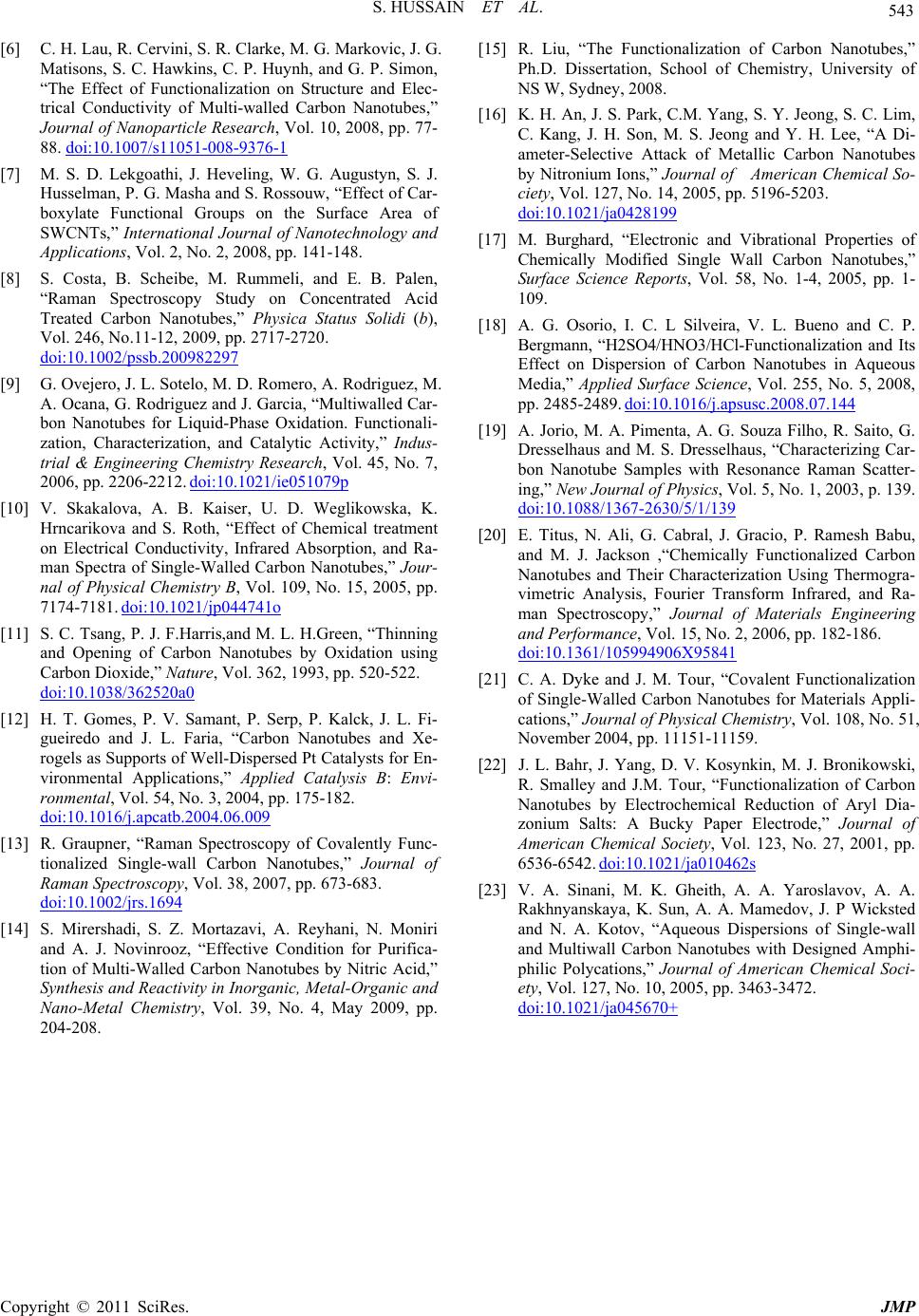
S. HUSSAIN ET AL.
Copyright © 2011 SciRes. JMP
543
[6] C. H. Lau, R. Cervini, S. R. Clarke, M. G. Markovic, J. G.
Matisons, S. C. Hawkins, C. P. Huynh, and G. P. Simon,
“The Effect of Functionalization on Structure and Elec-
trical Conductivity of Multi-walled Carbon Nanotubes,”
Journal of Nanoparticle Research, Vol. 10, 2008, pp. 77-
88. doi:10.1007/s11051-008-9376-1
[7] M. S. D. Lekgoathi, J. Heveling, W. G. Augustyn, S. J.
Husselman, P. G. Masha and S. Rossouw, “Effect of Car-
boxylate Functional Groups on the Surface Area of
SWCNTs,” International Journal of Nanotechnology and
Applications, Vol. 2, No. 2, 2008, pp. 141-148.
[8] S. Costa, B. Scheibe, M. Rummeli, and E. B. Palen,
“Raman Spectroscopy Study on Concentrated Acid
Treated Carbon Nanotubes,” Physica Status Solidi (b),
Vol. 246, No.11-12, 2009, pp. 2717-2720.
doi:10.1002/pssb.200982297
[9] G. Ovejero, J. L. Sotelo, M. D. Romero, A. Rodriguez, M.
A. Ocana, G. Rodriguez and J. Garcia, “Multiwalled Car-
bon Nanotubes for Liquid-Phase Oxidation. Functionali-
zation, Characterization, and Catalytic Activity,” Indus-
trial & Engineering Chemistry Research, Vol. 45, No. 7,
2006, pp. 2206-2212. doi:10.1021/ie051079p
[10] V. Skakalova, A. B. Kaiser, U. D. Weglikowska, K.
Hrncarikova and S. Roth, “Effect of Chemical treatment
on Electrical Conductivity, Infrared Absorption, and Ra-
man Spectra of Single-Walled Carbon Nanotubes,” Jour-
nal of Physical Chemistry B, Vol. 109, No. 15, 2005, pp.
7174-7181. doi:10.1021/jp044741o
[11] S. C. Tsang, P. J. F.Harris,and M. L. H.Green, “Thinning
and Opening of Carbon Nanotubes by Oxidation using
Carbon Dioxide,” Nature, Vol. 362, 1993, pp. 520-522.
doi:10.1038/362520a0
[12] H. T. Gomes, P. V. Samant, P. Serp, P. Kalck, J. L. Fi-
gueiredo and J. L. Faria, “Carbon Nanotubes and Xe-
rogels as Supports of Well-Dispersed Pt Catalysts for En-
vironmental Applications,” Applied Catalysis B: Envi-
ronmental, Vol. 54, No. 3, 2004, pp. 175-182.
doi:10.1016/j.apcatb.2004.06.009
[13] R. Graupner, “Raman Spectroscopy of Covalently Func-
tionalized Single-wall Carbon Nanotubes,” Journal of
Raman Spectroscopy, Vol. 38, 2007, pp. 673-683.
doi:10.1002/jrs.1694
[14] S. Mirershadi, S. Z. Mortazavi, A. Reyhani, N. Moniri
and A. J. Novinrooz, “Effective Condition for Purifica-
tion of Multi-Walled Carbon Nanotubes by Nitric Acid,”
Synthesis and Reactivity in Inorganic, Metal-Organic and
Nano-Metal Chemistry, Vol. 39, No. 4, May 2009, pp.
204-208.
[15] R. Liu, “The Functionalization of Carbon Nanotubes,”
Ph.D. Dissertation, School of Chemistry, University of
NS W, Sydney, 2008.
[16] K. H. An, J. S. Park, C.M. Yang, S. Y. Jeong, S. C. Lim,
C. Kang, J. H. Son, M. S. Jeong and Y. H. Lee, “A Di-
ameter-Selective Attack of Metallic Carbon Nanotubes
by Nitronium Ions,” Journal of American Chemical So-
ciety, Vol. 127, No. 14, 2005, pp. 5196-5203.
doi:10.1021/ja0428199
[17] M. Burghard, “Electronic and Vibrational Properties of
Chemically Modified Single Wall Carbon Nanotubes,”
Surface Science Reports, Vol. 58, No. 1-4, 2005, pp. 1-
109.
[18] A. G. Osorio, I. C. L Silveira, V. L. Bueno and C. P.
Bergmann, “H2SO4/HNO3/HCl-Functionalization and Its
Effect on Dispersion of Carbon Nanotubes in Aqueous
Media,” Applied Surface Science, Vol. 255, No. 5, 2008,
pp. 2485-2489. doi:10.1016/j.apsusc.2008.07.144
[19] A. Jorio, M. A. Pimenta, A. G. Souza Filho, R. Saito, G.
Dresselhaus and M. S. Dresselhaus, “Characterizing Car-
bon Nanotube Samples with Resonance Raman Scatter-
ing,” New Journal of Physics, Vol. 5, No. 1, 2003, p. 139.
doi:10.1088/1367-2630/5/1/139
[20] E. Titus, N. Ali, G. Cabral, J. Gracio, P. Ramesh Babu,
and M. J. Jackson ,“Chemically Functionalized Carbon
Nanotubes and Their Characterization Using Thermogra-
vimetric Analysis, Fourier Transform Infrared, and Ra-
man Spectroscopy,” Journal of Materials Engineering
and Performance, Vol. 15, No. 2, 2006, pp. 182-186.
doi:10.1361/105994906X95841
[21] C. A. Dyke and J. M. Tour, “Covalent Functionalization
of Single-Walled Carbon Nanotubes for Materials Appli-
cations,” Journal of Physical Chemistry, Vol. 108, No. 51,
November 2004, pp. 11151-11159.
[22] J. L. Bahr, J. Yang, D. V. Kosynkin, M. J. Bronikowski,
R. Smalley and J.M. Tour, “Functionalization of Carbon
Nanotubes by Electrochemical Reduction of Aryl Dia-
zonium Salts: A Bucky Paper Electrode,” Journal of
American Chemical Society, Vol. 123, No. 27, 2001, pp.
6536-6542. doi:10.1021/ja010462s
[23] V. A. Sinani, M. K. Gheith, A. A. Yaroslavov, A. A.
Rakhnyanskaya, K. Sun, A. A. Mamedov, J. P Wicksted
and N. A. Kotov, “Aqueous Dispersions of Single-wall
and Multiwall Carbon Nanotubes with Designed Amphi-
philic Polycations,” Journal of American Chemical Soci-
ety, Vol. 127, No. 10, 2005, pp. 3463-3472.
doi:10.1021/ja045670+